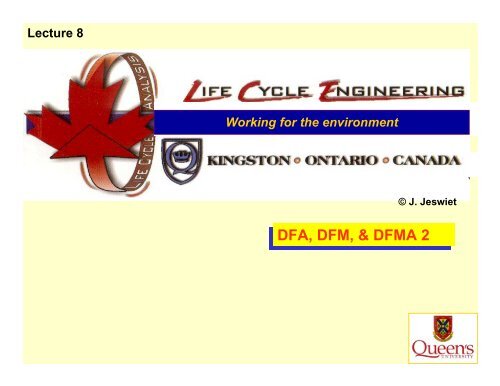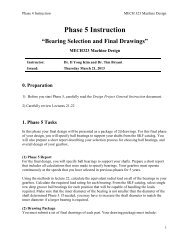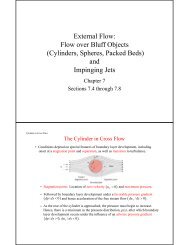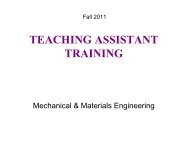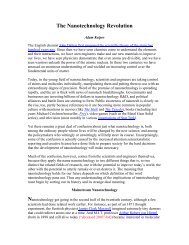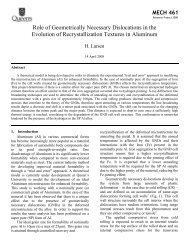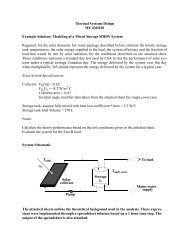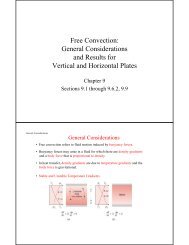DFA, DFM, & DFMA 2 DFA, DFM, & DFMA 2 - Department of ...
DFA, DFM, & DFMA 2 DFA, DFM, & DFMA 2 - Department of ...
DFA, DFM, & DFMA 2 DFA, DFM, & DFMA 2 - Department of ...
Create successful ePaper yourself
Turn your PDF publications into a flip-book with our unique Google optimized e-Paper software.
Lecture 8<br />
Working for the environment<br />
© J. Jeswiet<br />
<strong>DFA</strong>, <strong>DFM</strong>, & <strong>DFM</strong>A 2
<strong>DFA</strong> Guidelines<br />
1. Reduce number <strong>of</strong> parts<br />
2. Reduce number <strong>of</strong> different parts - Standardize parts<br />
3. Simplification <strong>of</strong> assembly<br />
4. Reduction number <strong>of</strong> processes<br />
5. Less fasteners especially screws & bolts<br />
6. Reduce tangling<br />
7. Orientation<br />
1. Critical orientation – obvious – see & fit<br />
2. Non-critical orientation – fit in any direction<br />
8. Ensure access & visibility<br />
9. Easy part handling<br />
10. Assemble from top<br />
11. Reduce locating/alignment operations – manual/time<br />
consuming
Reduce number <strong>of</strong> different parts -<br />
Standardize parts<br />
• One Time Costs<br />
– Tooling<br />
– Design/Development<br />
– Contacting / Vendor Selection<br />
– Product Testing<br />
• Continuous Costs<br />
– Material<br />
– Assembly<br />
– Inventory<br />
– Inspection
Simplification <strong>of</strong> Assembly<br />
• Easier = faster<br />
• Less opportunity for mistakes<br />
• Easier to automate
Reduction Number <strong>of</strong> Processes<br />
• Less steps = faster<br />
• Less material handling = less damage<br />
• Less operations = less opportunity for<br />
defects
Less Fasteners<br />
especially screws & bolts<br />
Left to right: simplest, low cost to most parts hardest to assembly<br />
Boothroyd & Dewhurst Inc, 1999
Reduce Tangling / Nesting<br />
• Takes time to separate<br />
• Requires people<br />
• Hard to automate<br />
Hugh Jack, Jack 2001
Orientation<br />
1. Critical orientation – obvious – see & fit<br />
2. Non-critical orientation – fit in any direction
Ensure Access & Visibility<br />
www.detnews.com/2004/project/0405/04/901-134795.htm<br />
www.uniontire.ca/tireassfr.htm
•Size<br />
• Weight<br />
• Shape<br />
• Sharp edges<br />
• Sticky<br />
• Tangled & Nested<br />
•etc.<br />
Easy part handling
Reduce locating/alignment operations –<br />
manual/time consuming<br />
Assemble from<br />
Top<br />
http://www.hfmgv.org/rouge/tour.asp#
From BDI Promo<br />
So in which industries can <strong>DFM</strong>A be used ?
The concept <strong>of</strong> <strong>DFM</strong>A has been introduced.<br />
However, there are many<br />
more methods and the<br />
following is a list<br />
compiled as part <strong>of</strong> a<br />
study* 1,2 <strong>of</strong> the use <strong>of</strong><br />
formal design methods<br />
within industry: industry<br />
* 1 Gouvinhas & Corbett, 1999, The<br />
use <strong>of</strong> design Methods within<br />
production machinery companies,<br />
IMECHE J. <strong>of</strong> Engineering<br />
Manufacture, vol 213, Part B, pp<br />
285 – 293.<br />
* 2 Seliger Production Innovation<br />
– Industrial Approach, Annals <strong>of</strong><br />
CIRP, 2001, vol. 2.
Flow chart for<br />
typical steps taken using <strong>DFM</strong>A techniques are:<br />
Design concept<br />
<strong>DFA</strong><br />
Selection <strong>of</strong> materials<br />
and processes and<br />
Early cost estimates<br />
Best design concept<br />
<strong>DFM</strong><br />
prototype<br />
Suggestions for<br />
simplification<br />
<strong>of</strong> product structure<br />
Suggestions for more<br />
economic materials, processes<br />
and environmentally friendly materials<br />
Detail design<br />
for minimum<br />
manufacturing<br />
costs<br />
production
The The Advantages <strong>of</strong> <strong>of</strong> Applying <strong>DFM</strong>A<br />
1. <strong>DFM</strong>A provides a systematic procedure for analyzing a proposed<br />
design from the point <strong>of</strong> view <strong>of</strong> assembly and manufacture.<br />
The result is simpler more reliable products which are less<br />
expensive to assemble and manufacture.<br />
2. Any reduction in the number <strong>of</strong> parts in an assembly produces a<br />
snowball effect on cost reduction because <strong>of</strong> drawings and<br />
specifications that are no longer needed; reduced overheads.<br />
3. Dialogue is encouraged between design and manufacturing<br />
engineers giving the teamwork an attitude necessary to<br />
concurrent engineering.<br />
Companies reporting large savings with <strong>DFM</strong>A are:<br />
Bombardier - Canadair Regional Jet Nacelles<br />
NCR - new point <strong>of</strong> sales terminals.<br />
Brown and Sharpe - measurement equipment
A typical product to which <strong>DFM</strong>A analysis can be applied is:<br />
We will now look at Design rules for Manual Assembly.<br />
Assembly
PROCEDURE FOR THE ANALYSIS OF MANUALLY ASSEMBLED PRODUCTS<br />
STEP 1. Obtain the best information about the product or assembly; useful<br />
items are:<br />
engineering drawings<br />
exploded 3-D views<br />
existing version <strong>of</strong> the product [for a redesign]<br />
a prototype<br />
STEP 2. Imagine how the assembly would be dismantled, or for a redesign<br />
do it with an actual part.<br />
Note: this is an important step for later DFD analysis.<br />
If the assembly contains subassemblies, treat these as parts first.<br />
STEP 3. Set up a worksheet with cells for appropriate entries<br />
part name, number <strong>of</strong> parts, theoretical part count, handling time,<br />
insertion time, assembly time, assembly cost<br />
STEP 4. Begin assembling, or re-assembling the product.<br />
Complete each row on the sheet. The column for the minimum theoretical<br />
number <strong>of</strong> parts is a critical step in this process.<br />
The estimated handling times and insertion times are obtained from the<br />
Boothroyd and Dewhurst tables.
STEP 5. When all <strong>of</strong> the rows have been completed (reassembled in effect), the<br />
assembly time column is added to give a total estimated assembly time.<br />
The estimated assembly cost column is also added to give a total estimated<br />
assembly cost.<br />
The theoretical minimum column is also summed.<br />
STEP 6. The design efficiency is calculated.<br />
Where N min = the theoretical part minimum<br />
E ma<br />
N .<br />
min t a<br />
t ma<br />
t a = the theoretical, lowest assembly time for one part<br />
This is an ideal minimum<br />
t ma = the estimated assembly time to complete assembly <strong>of</strong><br />
the actual product
The Pen Example<br />
• Take the pens apart<br />
• Determine the minimum theoretical parts<br />
• Check assembly time<br />
• Cost to assemble $50/hr rate<br />
– Now vs minimum time<br />
• Efficiency = Min. Parts* Min. Time/Actual<br />
Time
Handling & Insertion<br />
• Handling Time Factors<br />
– Orientation<br />
–Part Size<br />
– Ease <strong>of</strong> Handling<br />
• Insertion Time Factors<br />
– Type <strong>of</strong> Fastening<br />
– When secured
Orientation<br />
AXIS OF INSERTION<br />
Rotating a part about its axis <strong>of</strong> insertion: how many possible orientations are<br />
there?<br />
The more symmetric a part, the easier it is to install it, quickly and accurately.<br />
When a part is not<br />
symmetric, obvious<br />
external features<br />
make orientation<br />
easier for the<br />
operator.<br />
infinite<br />
orientations<br />
limited<br />
orientations
One <strong>of</strong> the principal geometric design features that affects times required to grasp<br />
and orient a part is symmetry.<br />
Experience shows there are two distinct operations in this:<br />
1. Alignment <strong>of</strong> the axis <strong>of</strong> the part that corresponds to the axis <strong>of</strong> insertion<br />
- called alpha rotation, α.<br />
2. Rotation <strong>of</strong> the part about its axis <strong>of</strong> insertion<br />
- called beta rotation, β.<br />
0 instead <strong>of</strong> infinity<br />
β<br />
α
Then, a plain square prism which is to be inserted into a square hole would<br />
first have to be rotated about an axis perpendicular to the insertion axis.<br />
This rotation will be repeated every 180 degrees and therefore has an alpha, α<br />
symmetry <strong>of</strong> 180 degrees.<br />
The square prism would then have to be rotated about the axis <strong>of</strong> symmetry for<br />
the part but in the beta direction. This give a beta, β, symmetry every 90 degrees.<br />
Note: if the square prism were inserted into a round hole it would have 180 o α<br />
symmetry and infinite or 0 β symmetry.<br />
Its has been found that the<br />
best single parameter to<br />
describe overall symmetry is<br />
simply the addition <strong>of</strong> alpha<br />
and beta, α + β, giving the<br />
total axis <strong>of</strong> symmetry.<br />
tables have been derived for<br />
total axis <strong>of</strong> symmetry.
Estimated Handling Times<br />
How<br />
handled<br />
Total<br />
axis<br />
<strong>of</strong><br />
symmetry<br />
Size <strong>of</strong> Part<br />
Time used later<br />
Source: Design for Assembly, © Boothroyd &<br />
Dewhurst 1983
Estimated Handling<br />
Time Table<br />
Total axis <strong>of</strong><br />
symmetry<br />
Size <strong>of</strong> Part<br />
Time used later<br />
How<br />
handled<br />
Source: Design for<br />
Assembly, © Boothroyd &<br />
Dewhurst 1983
Estimated Insertion Times<br />
Effort Required<br />
Fastening<br />
& Securing<br />
View<br />
Source: Design for Assembly, © Boothroyd &<br />
Dewhurst<br />
1983<br />
Time used later
Estimated InsertionTimes<br />
Source: Design for<br />
Assembly, © Boothroyd &<br />
Dewhurst 1983<br />
Effort Required<br />
Fastening<br />
& Securing<br />
View<br />
(obstructed vs<br />
unobstructed)<br />
Time used later
Case Study:<br />
Pneumatic<br />
Piston
Estimated Handling<br />
Time Table<br />
Source: Design for<br />
Assembly, © Boothroyd &<br />
Dewhurst 1983
Estimated Handling<br />
Time Table<br />
Source: Design for<br />
Assembly, © Boothroyd &<br />
Dewhurst 1983
Estimated InsertionTimes<br />
Estimated Insertion<br />
Source: Design for<br />
Time Assembly, Time © Boothroyd &<br />
Time Table<br />
Dewhurst 1983<br />
Source: Design for<br />
Assembly, © Boothroyd &<br />
Dewhurst 1983
Estimated InsertionTimes<br />
Estimated Insertion<br />
Source: Design for<br />
Time Assembly, Time © Boothroyd &<br />
Time Table<br />
Dewhurst 1983<br />
Source: Design for<br />
Assembly, © Boothroyd &<br />
Dewhurst 1983
Estimated InsertionTimes<br />
Estimated Insertion<br />
Source: Design for<br />
Time Assembly, Time © Boothroyd &<br />
Time Table<br />
Dewhurst 1983<br />
Source: Design for<br />
Assembly, © Boothroyd &<br />
Dewhurst 1983
Pneumatic Piston worksheet<br />
Part/subassembly Number Min # Handling Insertion Operator Operation<br />
or operation <strong>of</strong> items parts sec per item sec per item time, sec cost, cents<br />
1 main block 1 1 1.95 1.5 3.5 4.8<br />
2 piston 1 1 1.5 2.5 4.0 5.6<br />
3 piston stop 1 1 1.5 1.5 3.0 4.2<br />
4 spring 1 1 1.84 1.5 3.3 4.6<br />
5 cover 1 0 2.36 6.5 8.9 12.3<br />
6 screw 2 0 1.8 8 19.6 27.2<br />
7 4 42.3 58.7<br />
Labour cents Design eff = 0.28<br />
rate,$/hr /sec 28%<br />
50 1.39
CASE STUDY: controller assembly
Analysis sheet for controller assembly<br />
Part/subassembly Number Handling Insertion Operator Operation min Labour cents<br />
or operation <strong>of</strong> items sec per item sec per item time, sec cost, centspartsrate,$/hr /sec<br />
1 pressure regulator 1 2.0 1.5 3.5 4.8 1 50 1.39<br />
2 metal frame 1 1.95 5.5 7.5 10.3 1<br />
3nut 1 1.13 8 9.1 12.7 0<br />
4 reorientation 1 9 9.0 12.5<br />
5 sensor 1 1.95 6.5 8.5 11.7 1<br />
6 strap 1 1.8 6.5 8.3 11.5 0<br />
7 screw 2 1.8 8 19.6 27.2 0 Design eff =<br />
8 apply tape 1 12 12.0 16.7 0.07<br />
9 adaptor nut 1 1.5 10.5 12.0 16.7 0 7%<br />
10 tube assembly 1 3 4 7.0 9.7 0<br />
11 screw fastening 1 5 5.0 6.9<br />
12 pcb assembly 1 5.6 6.5 12.1 16.8 1<br />
13 screw 2 1.8 8 19.6 27.2 0<br />
14 connector 1 1.95 5 7.0 9.7 0<br />
15 ground lead 1 5.6 5 10.6 14.7 0<br />
16 reorientation 1 9 9.0 12.5<br />
17 knob assembly 1 1.95 6.5 8.5 11.7 1<br />
18 screw fastening 1 5 5.0 6.9<br />
19 plastic cover 1 1.95 6.5 8.5 11.7 0<br />
20 reorientation 1 9 9.0 12.5<br />
21 screw 3 1.8 10.5 36.9 51.3 0<br />
227.4 315.9 5
Design Change Item Time savings<br />
1 combine plastic cover with frame and eliminate 19, 20, 21 54.3<br />
screws & reorientation process<br />
2 Eliminate strap and 2 screws [provide snaps in plastic 6, 7 27.9<br />
frame tohold sensor if necessary]<br />
3 Eliminate screws holding PCB assembly 13 19.6<br />
[provide snaps in plastic frame]<br />
4 Eliminate two orientations 4, 16 18<br />
5 Eliminate tube assembly and 2 screwing operations 10, 11 12<br />
[screw adaptor nut and sensor into pressure regulator]<br />
6 Eliminate ground lead; unecessary with plastc shield 15 10.6<br />
7 Eliminate connector [plug sensor into PCB] 14 7<br />
Total: 149.4<br />
Time savings: 66%
Diaphragm<br />
assembly
Thank you for your attention<br />
Thank you for your attention
Design Rules for Manual Assembly:<br />
Assembly<br />
Note: In many cases the following rules can be used for either manual manual<br />
or<br />
robotic assembly.<br />
DESIGN GUIDELINES for PART HANDLING<br />
1. Design parts that have end to end<br />
symmetry and rotational symmetry<br />
about the axis <strong>of</strong> insertion, or strive for<br />
the closest available; see (a)<br />
2. If symmetry is not possible make it<br />
obvious the part is asymmetric (b)<br />
3. Use features that prevent jamming <strong>of</strong><br />
parts (c )<br />
4. Avoid features that allow<br />
entanglement in storage (d)<br />
5. Avoid parts that are slippery & delicate<br />
6. Avoid hazardous parts; sharp or<br />
splinter easily<br />
7. Use environmentally friendly materials
DESIGN GUIDELINES FOR<br />
INSERTION AND FASTENING<br />
This type <strong>of</strong> operation is very important<br />
in assembly, and therefore has many<br />
guidelines, all <strong>of</strong> which cannot be<br />
covered here.<br />
1. Keep resistance to<br />
insertion a minimum;<br />
chamfers are a help
DESIGN GUIDELINES for INSERTION and FASTENING<br />
(continued)<br />
2) standardize using common parts, processes and<br />
methods across all models and product lines<br />
where possible. Gives lower product cost.<br />
3) Use pyramid assembly, preferably from one axis<br />
<strong>of</strong> reference.<br />
4) Avoid, if possible, having to hold down parts to<br />
maintain orientation during any part <strong>of</strong> the<br />
operation.<br />
5. Design the part so it is located before released
DESIGN GUIDELINES for INSERTION and FASTENING (continued)<br />
6) When common mechanical fasteners are used the cost <strong>of</strong> the type <strong>of</strong> fastener<br />
used should be kept in mind.<br />
7) Avoid repositioning <strong>of</strong> a partially completed assembly in order to complete<br />
the operation<br />
snap<br />
fitting<br />
screwing<br />
plastic<br />
bending<br />
riveting
ADDITIONAL INFORMATION ABOUT SOME OF THE FOREGOING<br />
A great deal <strong>of</strong> research has been done on what we have seen so far and the<br />
experience gained has yielded many empirical equations. The following gives an<br />
idea <strong>of</strong> some <strong>of</strong> these relationships.<br />
Manual Insertion Time for both conical and curved chamfers<br />
For conical chamfers where the width <strong>of</strong> 45 o chamfers is W 1<br />
= 0.1d, the manual insertion time for a plain cylindrical peg, t i<br />
is given by:<br />
t i = -70 ln(c) + f(chamfers) + 3.7L+ 0.75d 10 -2 s<br />
or t i = 1.4L + 15 10 -2 s ; whichever is larger and where<br />
f(chamfers) equals one <strong>of</strong> the following:<br />
-100 [no chamfer], -220 [chamfer on hole], -250 [chamfer on<br />
peg], -370 [chamfer on peg and hole]<br />
For example for D = 20 mm, d = 19.5 mm, L = 75 mm, with<br />
chamfers on both the peg and hole:<br />
c = (20-19.5)/20 = 0.025<br />
t i = -70 ln(0.025) - 370 + 3.7(75)+ 0.75(19.5) = 181 10 -2 s<br />
t i = 1.4(75) + 15 = 120 10 -2 s<br />
To be conservative choose the higher value, 181 10 -2 s<br />
c is the diametral<br />
clearance<br />
c<br />
( D d)<br />
D
ADDITIONAL INFORMATION (cont’d)<br />
Effects <strong>of</strong> restricted access and vision on initial engagement <strong>of</strong> screw:
Torx
ADDITIONAL INFORMATION (cont’d)<br />
Holding parts in place
ADDITIONAL INFORMATION (cont’d)
ADDITIONAL INFORMATION (cont’d)
The following references were used for the <strong>DFM</strong>A<br />
presentations:<br />
PRODUCT DESIGN for MANUFACTURE and ASSEMBLY; Boothroyd, Dewhurst and<br />
Knight; © 1994 Marcel Dekker<br />
1999 International Forum on <strong>DFM</strong>A; Newport Rhode Island<br />
DESIGN for ASSEMBLY; Myrup, Kahler and Lund; © 1983 IFS Publications<br />
DESIGN for ASSEMBLY: a designers handbook 2 nd edition; © 1983 Boothroyd and<br />
Dewhurst<br />
Internet References<br />
http://engineer.gvsu.edu/vac/dfa.html….<br />
http: //www.design-ivcom/about.html…<br />
http:www.tue.nl/tm/rave/ce/dfma-2.html…..<br />
http:// clear.lakes/~eltechno/TVAsfd.html….<br />
http://sun.mpce.stu.mmu.ac.uk/pages/projects/dfe18/report18.html….<br />
http://rolf.ece.curtain.edu.au/~clive/jit/jit.htm….<br />
http://www.dfma.com/news/panel.html….<br />
http://www.danfoss.com/….<br />
http://www.ssd.gu.se/kid/swe/ssd0350.html…
Active websites which has <strong>DFM</strong>A study results<br />
http://www.dfma.com/news/panel.html<br />
http://www.dfma.com/news/cibacorn.html<br />
http://www.machinedesign.com/afiles/indexA.html<br />
http://www.dfma.com/news/Herrera.html


